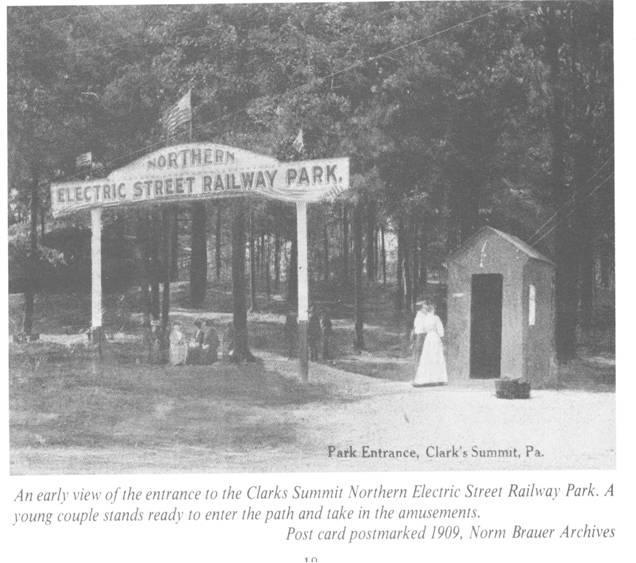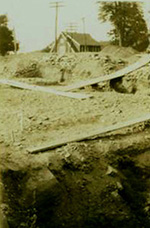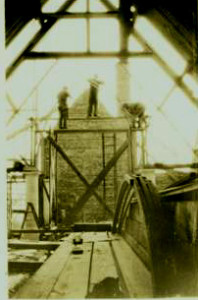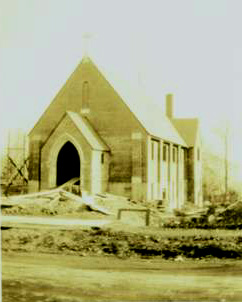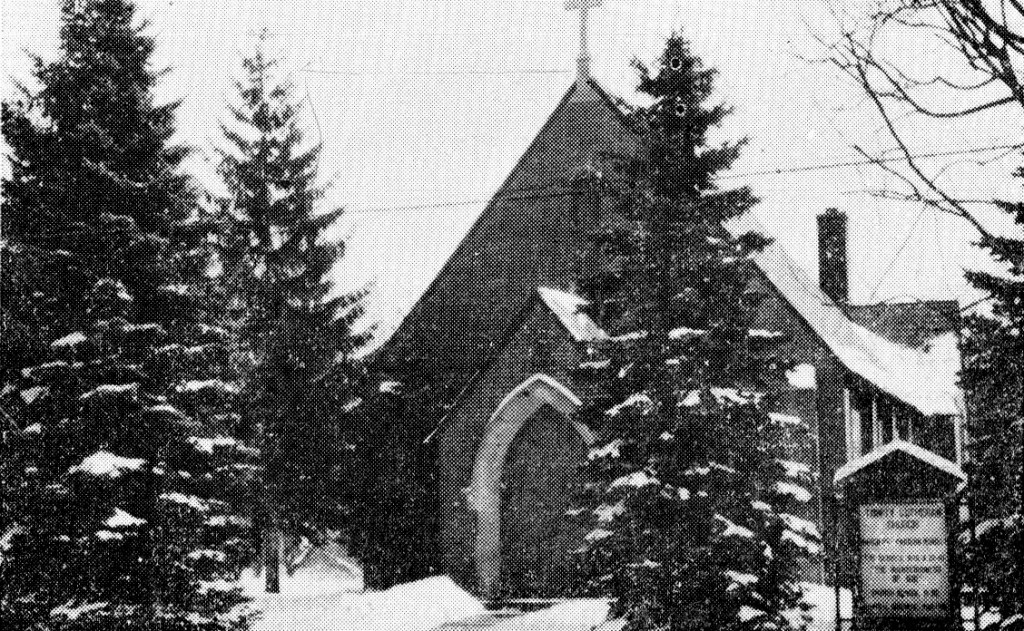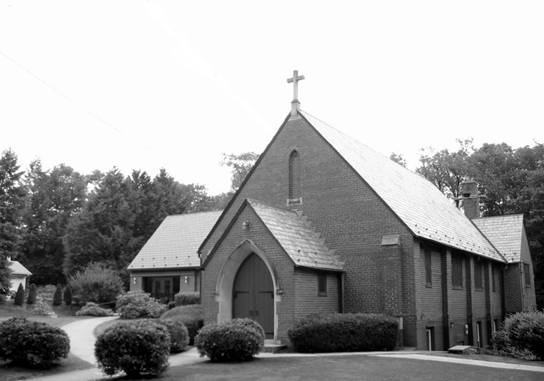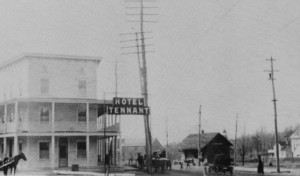Church History
A History of Trinity Lutheran Church, Clarks Summit, PA
Building the Church (1926 – 1941)
In 1926, there was no place in the Abingtons (Clarks Summit, PA and surrounding communities) for people of the Lutheran faith to Worship. A survey by Lutheran seminarian Edward Mattson was made in the area to see if there were a sufficient number of families residing in the area to form a new congregation. On March 21, 1926 the group gathered at the Knights of Malta Hall for services. The Knights of Malta Hall was located on the main street of Clarks Summit above the Davis Variety store which is now the building to the right of Benetton. We rented the hall for $15 per month. The average attendance was 32 people per Sunday for the entire year of 1928.
Property was purchased on the north edge of the former Northern Electric Park at a cost of $3,200. The cost proposal to build was $15,000. On hand was $2,223.95 in cash. A loan for $4,000 was secured. On April 26, 1929 a special meeting of the church council was held. It was reported that the Lackawanna Scranton Trust Company would take a first mortgage on our church building and property of $7,500. The mortgage would be advanced in installments after $3,000 of our own money was invested in the building.
A ground breaking service was held Sunday afternoon, August 11, 1929. Dedication of the church was held in August of the next year.
How did Trinity get its name? Marion Hopkins shared with us that prior to 1929, two German Lutheran churches in Scranton merged. These churches were Zion and Trinity. (Marion and Roy were members of Trinity). Before merging with Zion, Trinity heard that a Lutheran church was getting started in Clarks Summit. The Ladies Aid Society and the Missionary Society of Trinity gave the people in Clarks Summit a gift of a silver communion set and paten.
When Zion and Trinity merged they became St. John’s, Scranton which is now currently St. Matthews, Scranton. With the merger of the two churches they had a number of duplicate items. They gave the new church in Clarks Summit pews, hymnals and other items. As a way to show their gratitude to the church in Scranton, the members of the new Clarks Summit church decided to call their church Trinity.
Growing Pains (1942 – 1959)
In September 1942 repairs were made to the boiler, the roof of the coal bin and the steps to the basement entrance. The minutes stated: “the bill of $2.94 will be paid when sufficient funds are available.”
A special congregational meeting was called on May 21, 1943 to approve the signing of new mortgage papers. 25 members were present and more would have been present but a ban had been placed on driving that day due to gas shortages.
In 1944 Pastor Wein was given $5 a month toward his car expense. The pastors serving Trinity were dividing their time between Trinity and Lutheran churches in Scranton. In September 1949, seminarian William Dennis was called to serve both St. Paul’s and Trinity during June, July, and August. At that time, the church council decided to explore the possibility of having our own pastor. In December 1949, William Dennis accepted the call to be pastor of Trinity and was installed in June 1950 following his graduation from seminary. Pastor Dennis was our first full-time pastor.
Trinity rented a North State Street apartment for the parsonage for $75 a month which included heat, water and a garage.
Pastor Dennis was not in town very long before his lanky, six-foot frame, his coattails swinging in the breeze, became a familiar presence in the area as he greeted everyone he met.
One of the first (self-imposed) tasks he undertook was that of compiling a list of religious affiliations of all the residents of Clarks Summit. As he knocked on doors to question the occupants, this new presence in the community became even more pronounced. The survey was so thorough that several other churches asked for a copy.
There was one area in which Pastor Dennis appeared to be remiss–he was invariably late for Sunday school. It was later discovered that this was not because he overslept. Rather on Sunday mornings he could be found at the local diner where he held forth on various subjects to the delight of both the regular patrons and strangers passing through the town. It was his way of bringing his ministry to the people rather than the other way around.
In 1951 the organist had to resign because of difficulty pumping the organ. The general opinion was that any available organist had declined because of the physical difficulty of pumping. Council decided to look into the possibility of providing a blower for the organ, checking for valve leakage, or getting an approximate cost of an electric organ. There was some comment that this problem resulted from Pastor’s request that hymns be played in a more spirited manner. An organ fund was set up and a new organ was purchased.
Pastor Dennis discussed his plan to locate a larger parsonage with the cost not to exceed the present $75 per month and found one at 108 Coburn Avenue.
Also in 1952, thoughts of building a parsonage were presented at council. An architect presented sketches and an estimated cost of $22,000. A parsonage fund was started at this time.
In January of 1953, we purchased a lot on the other side of the present parish house for $1,200 plus taxes.
Mr. & Mrs. Seth Speck owned the property next to the church at 207 W. Grove Street, and Trinity finally purchased it for $19,000 in December 1955 and remodeled it.
There was quite a bit of discussion concerning the “size” of the church building and they began having two services in June 1954. Overall attendance increased because of the two services.
At one time Trinity was known as “The Church in the Pines” as it was surrounded by pine trees.
Rev. Burnite was installed as pastor on Sunday, April 5, 1959. During his time as pastor a brochure was printed stating: “Trinity is a congregation where the individual is important. We are small enough to be interested in the spiritual well-being of each one who attends; yet large enough to offer a full program to meet the spiritual needs of all.” “You are cordially invited to Trinity – the church in the pines.”
Church Expansion – The Transcept (1960 – 2009)
In May 1960 an expansion of the church was planned with an additional seating capacity of 90. The mortgage was not to exceed $67,000.
Sometime during the late 1960’s it was reported by the worship and music committee that ushers refused to wear boutonnieres. Also the last four rows would be roped off forcing people to sit closer to the front of the church!
In May of 1965 renovation plans to the chancel were discussed and finally completed in 1970 for $8,700.
In October of 1966 the Christian Education Committee set up procedures for operation of the Trinity Lutheran Nursery School to begin as soon as feasible. Pastor Elbert started the preschool with the help of Elva Reese and Carol and Fred Pencek. Elva was paid $100 per month which she gave back to buy supplies and materials needed for the school. The school was running smoothly by January of 1967. Elva was the first teacher and continued until August 1986. The school continued to operate under the name of Trinity Lutheran Pre-school as an educational outreach program to the community. For most of its history the school has offered 4 year old morning and afternoon classes three days a week and a three year old class two mornings a week. In 2019 the program expanded to include five year old children and has made a transition to a full early education program. Gena Gehris and Pam Scandale are the co-teachers for both the three, four and five year old programs; Marcy Pentasuglio, and Courtney Kocsis are serving as teaching assistants.
The renovation mortgage was burned on Reformation Sunday October 26, 1975.
In 1979 Rev. George J. Mathews, Jr. became the sixth full time pastor. Pastor Mathews conducted his first service as pastor of Trinity on August 26.
Shortly after Pastor Mathews arrived the congregation addressed some pressing property issues. For 50 years the parking lot had never been paved. Ruts, puddles and mud were typical of an inclement day. In the spring of 1980 the parking areas around the church and parsonage as well as the access to Bissell Street were paved.
At the same time the church kitchen was in desperate need of remodeling and updating. This project also was completed during 1980.
In the early 80’s we began having Saturday evening services in the summer. This additional service benefited members who would not have been able to otherwise attend services. In order to help make it possible for as many people to attend services as possible the Saturday evening services became a weekly opportunity beginning in the fall of 2001.
Trinity is very fortunate to have an excellent church library. Prior to the mid 1980’s the library had consisted of an assortment of books from a variety of sources. Under the direction of Terry Bockelkamp, a catalog system was developed and a circulation system was put in place. During this time period a donation of $100 from the church and a donation of $100 from the women’s organization made it possible for a number of books to be purchased for the library. The library has continued to grow since that time. At the present time there are approximately 2,000 books in the library. The resources in the library have been fine tuned to support the ministries of the church.
In 1985 the installation of a custom designed Baroque voiced pipe organ was completed. Larry Hoover built the wind chest and the toe board to accommodate two ranks of pipes. In addition to Larry’s craftsmanship reflected in the pipe organ, his woodworking expertise can be seen in manyother places throughout the church building. In the same year refinements to the chancel arrangement were also completed. In 2011 the console to the pipe organ was upgraded to include solid-state components which have added significant versatility to the instrument as well as dramatically extending the life expectancy of the console. These valuable additions contribute much to the beauty and celebration in our traditional liturgical style of worship.
In 1993 we installed a Schulmerich Carillon system, which was contributed by Elva Reese in memory of her husband Daniel. The carillon bell system plays hymns outdoors twice a day in addition to being used before, during, and after the worship services.
One of the things that surfaced often during the history of the congregation is discussion about “needing more space.” In 1994 the parsonage was converted into a parish house.. The parish house provides for classrooms on the first floor and office areas on the second floor. This change also meant that two rooms in the church building could be used for a single purpose: a church library and a choir room. Between the choir room and the library a third room is available for small group meetings. Although the creation of the parish house did help to alleviate the space problem at that time, we continue to need more space.
In 1999 probably the coolest thing that ever happened at Trinity took place. The church was air-conditioned!
The Parish Center (2010 – )
In 2010, Trinity Lutheran Church was named as one of several beneficiaries in the estate of Robert Wagner. The church received $1.6 million dollars. For the preceding 15 years we had been discussing the needs of our ministry areas regarding church accommodations. A long-range planning team under the direction of Bill Calhoun had recommended tearing down the old Parish house and building an education wing for the church. Of particular need was permanent Sunday School rooms that didn’t have to transition to other uses during the week, expanded offices, and a much larger fellowship area that could accommodate our growing church family. For those preceding 15 years it looked like an impossible dream. Yet Pastor Mathews continued to urge our congregational council to think strategically and to trust that God would provide the means at the right time. Pastor’s leadership and perseverence was inspiring to all of us. The windfall from the Wagner Estate was a welcomed surprise, and gave us the opportunity to turn our dream into a reality.
The congregational council consulted a building consultant provided by ELCA, and formed several committees to evaluate specific space needs, to ensure the space needs were directly tied to the ministries of the church, to select an architect, and to handle the finances. Chief leaders during this time were William Oehler, leading the property surveying, architect selection, and building design, Ray Keller who did an incredible job managing the building project and preventing cost overruns, and Barbara Strangfeld, who as Vice-President of council faced the burden of balancing many opposing ideas and interests, keeping us on target, while at the same time handling an ill-timed and ill-conceived lawsuit by a congregation member who seemed to be interested in personally gaining from the estate windfall.
Construction started in the fall of 2011 and, due to the most amazingly dry and warm winter ever, was completed in time for Sunday School to start in September, 2012.
After serving as the pastor of Trinity for thirty-seven years, Pastor Mathews retired from the active ministry at the beginning of October 2016.
On September 22, 2019, after considerable conversation and a series of in-depth educational meetings the decision was made to terminate the membership of the congregation in the Evangelical Lutheran Church in America (E.L.C.A.) and affiliate as a congregation of the North American Lutheran Church (N.A.L.C.). Pastor Mathews returned to serve Trinity as its interim pastor at the end of March 2019. During this time as the interim pastor, Pastor Mathews became a pastor within the North American Lutheran Church.
Additional Historical Pictures
The picture at left is of the Hotel Tennant in Clarks Summit in the early 1900’s. This building still stands today at the intersection of Depot and State St.
This is a drawing of the church as it originally appeared. Subsequently an addition was built on the left side.
This is a picture of the dance pavilion in the center of the Nothern Electric Park. This area would have been behind the church.
Ariel picture of the Grove street bridge and the Northern Electric park in the upper-middle of the picture
Hand drawn picture of the Northern Electric Park




